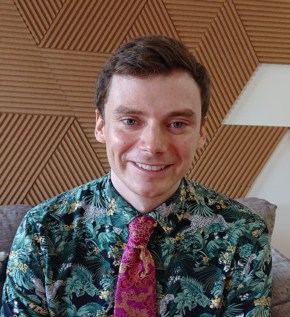How Space Pride is campaigning for change in the space sector
24 Aug 2023 Anna Demming
Anna Demming describes how a new charity called Space Pride wants to challenge the space industry’s outdated attitudes to diversity by hosting a fashion gala at a major space congress in Milan next year
Space for all Created by Rania Djojosugito and Khushi Shah, this artwork aims to represent people from all walks of life and a digital version of it will be on board SpaceX’s lunar lander, which is scheduled for launch in early 2024. (Courtesy: Rania Djojosugito, Khushi Shah and Space Pride)
Milan is a city synonymous with fashion, where designers and haute couture descend every September for its annual fashion week. Shortly after next year’s event, however, Milan will host another cultural milestone – the first Space Pride Fashion Gala. Running from 14 to 18 October 2024, the event promises to be “an out-of-this-world Pride parade” that builds on the latest advances in “technofabrics” – material that incorporate technology or functionality into a traditional textile.
“It’s a fashion show with the theme of Pride parade meets space,” explains Franceso (Franco) Labia, a theoretical physicist who is currently doing a PhD at the Bristol Robotics Laboratory in the UK. Franco, who is both bisexual and nonbinary, has been a main driver behind the international charity Space Pride, having founded it in October 2022 (see box below).
By staging the Space Pride Fashion Gala during the 75th annual congress of the International Astronautical Federation (IAF), which is also being held next October in Milan, the charity aims to pose “a joyful protest” on behalf of the LGBTQIA+ community working in the space industry, whose needs – or even existence – are not always well recognized. Partners for the occasion include Pride in STEM, KOSMICA, InnovaSpace, International Space University, Cumulus Association, the European Space Foundation and the IAF itself.
Space Pride and the gala are motivated by a desire to shift attitudes in the space industry. Despite deploying the latest, cutting-edge technology, Franco says the space sector is “a bit of a dinosaur” that is decades behind the rest of the world on diversity issues, and in particular the rights of the LGBTQIA+ community. Tackling the space industry’s backwardness is not, however, easy given that the sector is a worldwide endeavour and operates in many countries, including those where homophobic attitudes are still enshrined in law.
Individuals from the LGBTQIA+ community who work for space companies in those nations can therefore end up suppressing a part of their identity to avoid discrimination. However, Franco believes the problems cannot simply be attributed to disparities in the accepted norms of nations on LGBTQIA+ issues. “Compared to other sectors, the space sector has only just started talking about women,” says Franco. “They’ve barely spoken about racism. And they haven’t even begun to talk about disability and neurodiversity in terms of the widespread space community.”
Franco, who personally identifies with the LGBTQIA+ community, says the archaic attitudes are not helped by the IAF conference being routinely held in countries with homophobic laws, including those where gay marriage is not permitted. “Every time such an influential conference, which has 5000+ attendees, is held in one of those countries, the queer community lags behind,” says Franco. “That’s one problem – it’s not one with an easy solution.”
Pockets of the space sector are beginning to catch on, and for good reason since employers have a vested interest in ensuring their employees feel comfortable in the workplace however they identify. “People don’t realize how our personal lives and professional lives interact with each other,” says Dhanisha Sateesh, an aerospace engineer at the Indian space data company Pixxel. “I believe if you are in a closeted space and are not able to express yourself freely, you will not be able to give yourself 100% all of the time.”
Ramping up efforts
This kind of “psychological safety” in the workplace is not just an abstract notion: it helps the space sector to produce more effective results. That’s one reason why Sateesh champions these issues through her work on the diversity and gender equality group at the Space Generation Advisory Council (SGAC) – a non-profit body that represents students and young professionals who are interested in working in the space industry. “It’s such a great platform because it offers access to voices across the world,” says Sateesh. “There’s no bias and you get to know about what each person is doing and contributing to the space sector.”
As a woman, Sateesh, who designs satellites, found herself something of a rarity during her studies at the Sri Shanmugha College of Engineering and Technology in India, and welcomed the chance to share experiences with like-minded people. Yet she does not consider the lack of bias characteristic of the space industry, highlighting the “selection bias” in choosing astronauts. “There’s different levels of discrimination we all face together,” she says.
Sateesh identifies as female with an undefined sexuality, and it was her work to combat gender inequalities at SGAC that brought her into touch with Space Pride, where she is now a member. Indeed, Space Pride now has several members championing LGBTQIA+ rights within other organizations. Rynee Fandora, for example, is co-lead of the IAF’s LGBTQ+ working group. Having faced her own challenges regarding the freedom to express herself as a trans woman, she feels it is not just the LGBTQIA+ community who lose out when they are not embraced and encouraged in the space sector. “We are in a professional arena when we talk about space,” she says. “We need everyone in because their voice is important, and their ideas are important.”
Some space organizations are now trying to address the shortfall in provisions for the LGBTQIA+ community. Indeed, Neela Rajendra, who is now chief inclusion officer at NASA’s Jet Propulsion Laboratory, believes a lot of organizations have ramped up their efforts on diversity, equity and inclusivity issues in recent years. “I don’t think I am exaggerating when I say there was a world reckoning following the murder of George Floyd [in 2020],” she says. “[It led to greater] awareness and willingness and commitment to change from the perspective of diversity, equity and inclusion.”
One of the first things she did in her role was to ensure that the leaders of various employee resource groups, which represent marginalized populations in the organization, are paid for their time. As she sees it, people should not be expected to do the work for free, as is so often the case. JPL also pays for group leaders to attend diversity-related professional development conferences. She says that while the atmosphere at the organization is generally embracing of freedom of expression, many very practical, pressing and frustratingly familiar challenges remain, ranging from installing gender-neutral toilets to automating how pronouns of choice are included in JPL e-mails.
In April 2022 NASA released its diversity, equity and accessibility (DEIA) strategic plan for its workforce. Elaine Ho, the space agency’s chief diversity officer, told Physics World that this includes goals that drive equitable access to professional opportunities and support services, aiming to prevent unconscious bias, while enhancing workforce diversity, and ensuring DEIA integration into all NASA missions. Earlier this year NASA also surveyed its employees to find out what issues exist and how best to address them.
A quest for equity: Franco Labia
Born in South Africa in 1997, Franco Labia left the country in 2016 due to not feeling “welcome as a queer and neurodivergent individual”. After studying theoretical physics at the University of Leeds in the UK, Franco is now doing a PhD at the Bristol Robotics Laboratory, which is co-run by the University of Bristol and the University of the West of England. Having led many campaigns to champion diversity and inclusion, Franco’s first forays into activism were prompted by their experiences at a summer school organized by the International Space University (ISU) in 2022. Despite many world-leading astronauts teaching at the ISU, Franco was disappointed to see a lack of African involvement. “Africa didn’t have a seat at that table,” says Franco.
In response, later that year Franco set up and ran a community-based campaign to elect the first African board of trustees representative. The campaign was met “with an outpouring of support” and an African representative was successfully elected.
As well as Space Pride, Franco is also the youngest committee member at the British Standards Institute – where they represent the Bristol Robotics Laboratory – working on producing the world’s first sustainability-in-robotics standard. The standard can be used to influence both policy and research in robotics. Franco, who also has ADHD and a specific learning difficulty, feels that neurodiversity is disproportionately prevalent among both the Pride and space communities, but is rarely discussed – and that talking about it more could make a big difference for many people.
To the stars
Franco laments the lack of clear documentation of discrimination among the LGBTQIA+ community in the space sector despite the anecdotal evidence. While a key aim of Space Pride is simply getting the conversation started on LGBTQIA+ issues in the space sector through education and outreach, another is to conduct research that fills this void, providing, as he puts it, “actionable data that can be used to reduce the discrimination that the queer community face”. The third is to provide a platform for the community, which is where the fashion gala comes in.
As another step towards wider acknowledgement of the LGBTQIA+ community in space, Space X’s lunar lander, which is set for launch in early 2024, will – thanks to the Interstellar Foundation – carry a digital version of Space Pride inspired artwork created by Rania Djojosugito and Khushi Shah with help from the Space Pride team (see main image). The artwork is part of a project by the foundation to create a message in a bottle as part of the cargo of an interstellar probe that presents a snapshot of Earth to any possible extraterrestrials who might find it – an upgraded version of the Golden Records borne by Voyager 1 and 2.
“’We are all made of stardust’,” says Franco, quoting the Space Pride slogan. “We are all human and we should welcome and accept everyone.”For more information on the Space Pride Fashion Gala, e-mail spaceprideorg@gmail.com or follow Space Pride on social media

Anna Demming is a science journalist based in Bristol, UK
FROM PHYSICSWORLD.COM 24/8/2023


Δεν υπάρχουν σχόλια:
Δημοσίευση σχολίου